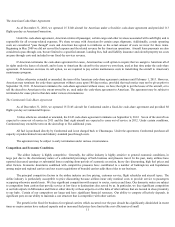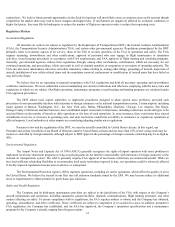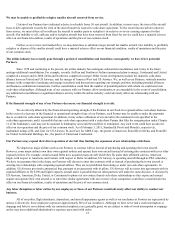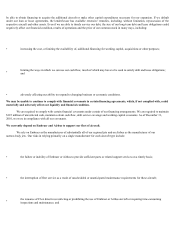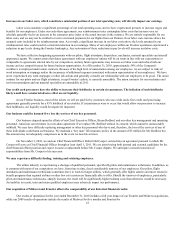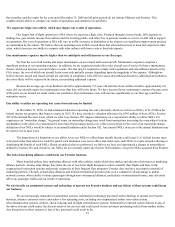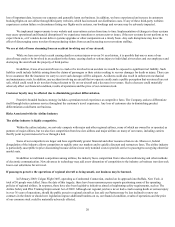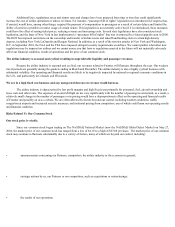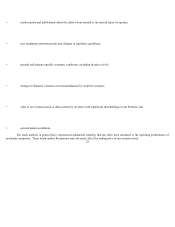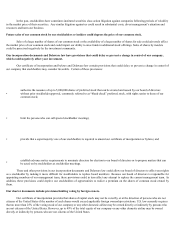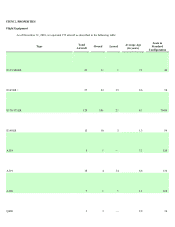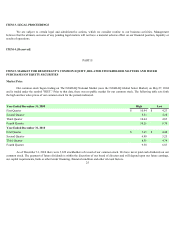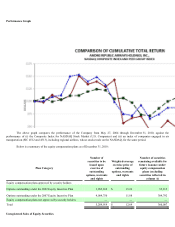Frontier Airlines 2010 Annual Report Download - page 27
Download and view the complete annual report
Please find page 27 of the 2010 Frontier Airlines annual report below. You can navigate through the pages in the report by either clicking on the pages listed below, or by using the keyword search tool below to find specific information within the annual report.three months, and the results for the year ended December 31, 2008 and all prior periods do not include Midwest and Frontier. This
complicates the ability to compare our results of operations and statement of cash flows.
We experience high costs at DIA, which may impact our results of operations.
Our largest hub of flight operations is DIA where we experience high costs. Financed through revenue bonds, DIA depends on
landing fees, gate rentals, income from airlines and the traveling public, and other fees to generate income to service its debt and to support
its operations. Our cost of operations at DIA will vary as traffic increases or diminishes at the airport or as significant improvement projects
are undertaken by the airport. We believe that our operating costs at DIA exceed those that other airlines incur at most hub airports in other
cities, which decreases our ability to compete with other airlines with lower costs at their hub airports.
Our maintenance expenses may be higher than we anticipate and will increase as our fleet ages.
We bear the cost of all routine and major maintenance on our owned and leased aircraft. Maintenance expenses comprise a
significant portion of our operating expenses. In addition, we are required periodically to take aircraft out of service for heavy maintenance
checks, which can increase costs and reduce revenue. We also may be required to comply with regulations and airworthiness directives the
FAA issues, the cost of which our aircraft lessors may only partially assume depending upon the magnitude of the expense. Although we
believe that our owned and leased aircraft are currently in compliance with all FAA issued airworthiness directives, additional airworthiness
directives likely will be required in the future, necessitating additional expense.
Because the average age of our Embraer aircraft is approximately 5.5 years old and that of our Airbus aircraft is approximately 6.0
years old, our aircraft require less maintenance now than they will in the future. We have incurred lower maintenance expenses because most
of the parts on our aircraft are under multi-year warranties. Our maintenance costs will increase significantly as our fleet ages and these
warranties expire.
Our ability to utilize net operating loss carry-forwards may be limited.
At December 31, 2010, we had estimated federal net operating loss carry-forwards, which we refer to as NOLs, of $1.3 billion for
federal income tax purposes that begin to expire in 2015. We have recorded a valuation allowance for $345 million of those NOLs. Section
382 of the Internal Revenue Code, which we refer to as Section 382, imposes limitations on a corporation's ability to utilize NOLs if it
experiences an “ownership change.” In general terms, an ownership change may result from transactions increasing the ownership of certain
stockholders in the stock of a corporation by more than 50 percentage points over a three-year period. In the event of an ownership change,
utilization of our NOLs would be subject to an annual limitation under Section 382. Any unused NOLs in excess of the annual limitation may
be carried over to later years.
The imposition of a limitation on our ability to use our NOLs to offset future taxable income could cause U.S. federal income taxes
to be paid earlier than otherwise would be paid if such limitation were not in effect and could cause such NOLs to expire unused, reducing or
eliminating the benefit of such NOLs. Based on analysis that we performed, we believe we have not experienced a change in ownership as
defined by Section 382, and, therefore, our NOLs are not currently under any Section 382 limitation, except for NOLs acquired from Frontier.
The lack of marketing alliances could harm our Frontier business.
Many branded airlines have marketing alliances with other airlines, under which they market and advertise their status as marketing
alliance partners. Among other things, they share the use of two-letter flight designator codes to identify their flights and fares in the
computerized reservation systems and permit reciprocity in their frequent flyer programs. Frontier does not have an extensive network of
marketing partners. The lack of marketing alliances and limited international presence puts us at a competitive disadvantage to global
network carriers, whose ability to attract passengers through more widespread alliances, particularly on international routes, may adversely
affect our passenger traffic and our results of operations.
We rely heavily on automated systems and technology to operate our Frontier business and any failure of these systems could harm
our business.
We are increasingly dependent on automated systems, information technology personnel and technology to operate our Frontier
business, enhance customer service and achieve low operating costs, including our computerized airline reservation system,
telecommunication systems, website, check-in kiosks and in-flight entertainment systems. Substantial or repeated system failures to any of
the above systems could reduce the attractiveness of our services and could result in our customers purchasing tickets from another airline.
Any disruptions in these systems or loss of key personnel could result in the
19


